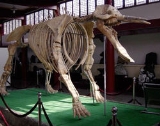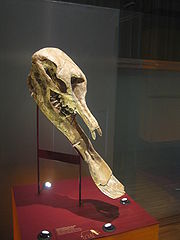
Platybelodon
Encyclopedia
Platybelodon was a genus
of large herbivorous
mammal
related to the elephant
(order Proboscidea
). It lived during the Miocene Epoch, about 15-4 million years ago, and ranged over Africa
, Europe
, Asia
and North America
. Although it thrived during its time, it did not survive past the Miocene.
s, using its teeth to shovel up aquatic and semi-aquatic vegetation. However, wear patterns on the teeth suggest that it used its lower tusks to strip bark
from tree
s, and may have used the sharp incisor
s that formed the edge of the "shovel" more like a modern-day scythe
, grasping branches with its trunk and rubbing them against the lower teeth to cut it from a tree.
 Platybelodon was very similar to Amebelodon
Platybelodon was very similar to Amebelodon
, another, closely related gomphothere
genus. Due to the shape of the two lower teeth, which are worn by many gomphothere genera (such as Platybelodon, Archaeobelodon
, and Amebelodon
), they are popularly known as "shovel tuskers."
Genus
In biology, a genus is a low-level taxonomic rank used in the biological classification of living and fossil organisms, which is an example of definition by genus and differentia...
of large herbivorous
Herbivore
Herbivores are organisms that are anatomically and physiologically adapted to eat plant-based foods. Herbivory is a form of consumption in which an organism principally eats autotrophs such as plants, algae and photosynthesizing bacteria. More generally, organisms that feed on autotrophs in...
mammal
Mammal
Mammals are members of a class of air-breathing vertebrate animals characterised by the possession of endothermy, hair, three middle ear bones, and mammary glands functional in mothers with young...
related to the elephant
Elephant
Elephants are large land mammals in two extant genera of the family Elephantidae: Elephas and Loxodonta, with the third genus Mammuthus extinct...
(order Proboscidea
Proboscidea
Proboscidea is a taxonomic order containing one living family, Elephantidae, and several extinct families. This order was first described by J. Illiger in 1881 and encompasses the trunked mammals...
). It lived during the Miocene Epoch, about 15-4 million years ago, and ranged over Africa
Africa
Africa is the world's second largest and second most populous continent, after Asia. At about 30.2 million km² including adjacent islands, it covers 6% of the Earth's total surface area and 20.4% of the total land area...
, Europe
Europe
Europe is, by convention, one of the world's seven continents. Comprising the westernmost peninsula of Eurasia, Europe is generally 'divided' from Asia to its east by the watershed divides of the Ural and Caucasus Mountains, the Ural River, the Caspian and Black Seas, and the waterways connecting...
, Asia
Asia
Asia is the world's largest and most populous continent, located primarily in the eastern and northern hemispheres. It covers 8.7% of the Earth's total surface area and with approximately 3.879 billion people, it hosts 60% of the world's current human population...
and North America
North America
North America is a continent wholly within the Northern Hemisphere and almost wholly within the Western Hemisphere. It is also considered a northern subcontinent of the Americas...
. Although it thrived during its time, it did not survive past the Miocene.
Palaeobiology
Platybelodon was previously believed to have fed in the swampy areas of grassy savannaSavanna
A savanna, or savannah, is a grassland ecosystem characterized by the trees being sufficiently small or widely spaced so that the canopy does not close. The open canopy allows sufficient light to reach the ground to support an unbroken herbaceous layer consisting primarily of C4 grasses.Some...
s, using its teeth to shovel up aquatic and semi-aquatic vegetation. However, wear patterns on the teeth suggest that it used its lower tusks to strip bark
Bark
Bark is the outermost layers of stems and roots of woody plants. Plants with bark include trees, woody vines and shrubs. Bark refers to all the tissues outside of the vascular cambium and is a nontechnical term. It overlays the wood and consists of the inner bark and the outer bark. The inner...
from tree
Tree
A tree is a perennial woody plant. It is most often defined as a woody plant that has many secondary branches supported clear of the ground on a single main stem or trunk with clear apical dominance. A minimum height specification at maturity is cited by some authors, varying from 3 m to...
s, and may have used the sharp incisor
Incisor
Incisors are the first kind of tooth in heterodont mammals. They are located in the premaxilla above and mandible below.-Function:...
s that formed the edge of the "shovel" more like a modern-day scythe
Scythe
A scythe is an agricultural hand tool for mowing grass, or reaping crops. It was largely replaced by horse-drawn and then tractor machinery, but is still used in some areas of Europe and Asia. The Grim Reaper is often depicted carrying or wielding a scythe...
, grasping branches with its trunk and rubbing them against the lower teeth to cut it from a tree.

Amebelodon
Amebelodon is a member of a diverse group of primitive proboscideans called gomphotheres, a group that also gave rise to the modern elephants and their close relative the mammoth. The most striking attribute of this animal is its lower tusks, which are narrow, elongated,and distinctly flattened...
, another, closely related gomphothere
Gomphothere
Gomphotheriidae is a diverse taxonomic family of extinct elephant-like animals , called gomphotheres. They were widespread in North America during the Miocene and Pliocene epochs, 12-1.6 million years ago. Some lived in parts of Eurasia, Beringia and, following the Great American Interchange,...
genus. Due to the shape of the two lower teeth, which are worn by many gomphothere genera (such as Platybelodon, Archaeobelodon
Archaeobelodon
Archaeobelodon is an extinct genus of proboscidea of the family Gomphotheriidae endemic to Europe and Africa during the Miocene from 16.9—16.0 Ma, living for approximately ....
, and Amebelodon
Amebelodon
Amebelodon is a member of a diverse group of primitive proboscideans called gomphotheres, a group that also gave rise to the modern elephants and their close relative the mammoth. The most striking attribute of this animal is its lower tusks, which are narrow, elongated,and distinctly flattened...
), they are popularly known as "shovel tuskers."

